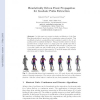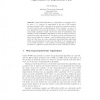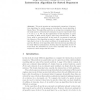WADS
2005
Springer
14 years 10 months ago
2005
Springer
Abstract. In this paper we consider a generalization of the edge dominating set (EDS) problem, in which each edge e needs to be covered be times and refer to this as the b-EDS prob...
WABI
2005
Springer
14 years 10 months ago
2005
Springer
Motifs in a network are small connected subnetworks that occur in significantly higher frequencies than in random networks. They have recently gathered much attention as a useful ...
VLSM
2005
Springer
14 years 10 months ago
2005
Springer
In this paper we present a simple modification of the Fast Marching algorithm to speed up the computation using a heuristic. This modification leads to an algorithm that is simil...
UC
2005
Springer
14 years 10 months ago
2005
Springer
Consider a database most of whose entries are marked but the precise fraction of marked entries is not known. What is known is that the fraction of marked entries is 1 − , where ...
STACS
2005
Springer
14 years 10 months ago
2005
Springer
Exponential algorithms, i.e. algorithms of complexity O(cn ) for some c > 1, seem to be unavoidable in the case of NP-complete problems (unless P=NP), especially if the problem ...
STACS
2005
Springer
14 years 10 months ago
2005
Springer
We provide a deterministic algorithm that constructs small point sets exhibiting a low star discrepancy. The algorithm is based on recent results on randomized roundings respectin...
SPIRE
2005
Springer
14 years 10 months ago
2005
Springer
We present a new algorithm for generating super condensed neighbourhoods. Super condensed neighbourhoods have recently been presented as the minimal set of words that represent a p...
SPIRE
2005
Springer
14 years 10 months ago
2005
Springer
Abstract. This work presents an experimental comparison of intersection algorithms for sorted sequences, including the recent algorithm of Baeza-Yates. This algorithm performs on a...
SPIN
2005
Springer
14 years 10 months ago
2005
Springer
We present a novel algorithm for repairing structurally complex data. Given an assertion that represents desired structural integrity constraints and a structure that violates them...
SG
2005
Springer
14 years 10 months ago
2005
Springer
This paper presents a smart algorithm for labeling column charts and their derivatives. To efficiently solve the problem, we separate it into two sub-problems. We first present a ...





